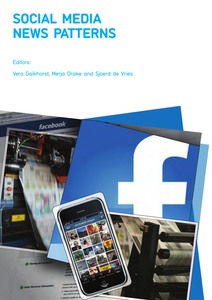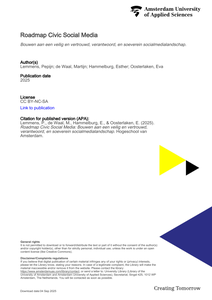Wereldwijd onderzoek: Hoe gebruiken nieuwsmedia social media? Jongeren lezen geen krant meer, ze kijken op hun smartphone die ze altijd bij de hand hebben. Binnen het lectoraat social media en reputatiemanagement van NHL hogeschool te Leeuwarden heeft een groep internationale studenten in 12 landen onderzoek gedaan. Hierbij hebben ze meer dan 150 social media sites bestudeerd van nieuws media. De resultaten maken deel uit van een internationaal onderzoek van NHL Hogeschool en Haaga Helia University. De onderzoeksvraag was: Wat speelt zich af in de nieuwsmedia? Persbureaus kunnen het overzicht gebruiken om hun social media te optimaliseren. En voor ieder die journalistiek een warm hart toedraagt is het interessante informatie over de nieuwsmedia in een overgangssituatie (2nd edition)
DOCUMENT

Turkey has received consistent criticism from international media for having many naturalized athletes in its national squad, both in the Olympic Games and other major international sporting events. Similar criticisms have also been a feature of debates for a long time in domestic media, varying in views toward these athletes. This research focuses on media representations of naturalized athletes in Turkey between 2008 and 2020. We investigated the sentiments of news items from four major Turkish newspapers (Milliyet, Cumhuriyet, Sabah and Fanatik) on their stances toward naturalized athletes over the timespan of 2008–2020. Beside analyzing the sentiment of the media content both cumulatively and fragmentedly, we also identified the yearly trends and most featured sports in this context, combining qualitative and quantitative techniques. Our findings showed that sentiments in Turkish media toward naturalized athletes are mostly neutral and negative as well as with differences varying on the basis of the newspapers and news item types. The most criticism underlined pursuing “shortcut” success with naturalized athletes representing Turkey in the international arena. Among the featured sports, basketball, football, and track and field have been the most discussed ones in the naturalization context.
DOCUMENT

Media Do Not Exist: Performativity and Mediating Conjunctures by Jean-Marc Larrue and Marcello Vitali-Rosati offers a radically new approach to the phenomenon of mediation, proposing a new understanding that challenges the very notion of medium. It begins with a historical overview of recent developments in Western thought on mediation, especially since the mid 80s and the emergence of the disciplines of media archaeology and intermediality. While these developments are inseparable from the advent of digital technology, they have a long history. The authors trace the roots of this thought back to the dawn of philosophy. Humans interact with their environment – which includes other humans – not through media, but rather through a series of continually evolving mediations, which Larrue and Vitali-Rosati call ‘mediating conjunctures’. This observation leads them to the paradoxical argument that ‘media do not exist’. Existing theories of mediation processes remain largely influenced by a traditional understanding of media as relatively stable entities. Media Do Not Exist demonstrates the limits of this conception. The dynamics relating to mediation are the product not of a single medium, but rather of a series of mediating conjunctures. They are created by ceaselessly shifting events and interactions, blending the human and the non-human, energy, and matter.
MULTIFILE
Een van de belangrijkste ontwikkelingen in het onderwijs is het gebruik van nieuwe kennismedia: media voor het genereren, begrijpen en delen van kennis. Denk aan social media, serious gaming, apps, tablets en smartphones. De grote vraag is: hoe ga je als school om met deze mediaontwikkelingen? In dit whitepaper presenteren we de roadmap van ons onderzoek naar de educatieve implementatie van de iPad (Engelstalig document)
DOCUMENT

This study examines the motives of employees to engage in workrelated social media use – i.e. the use of personal social mediaaccounts to communicate about work-related issues. The theory ofplanned behavior (TPB) was used to explain this behavior.Because social media can enable users to express theiridentities, social identity expressiveness and self-identityexpressiveness were added to the TPB model. Through an onlinequestionnaire, using purposive sampling technique, 514 Dutchemployees were asked about their social media use and motivationto do so. We used structural equation modelling (SEM) to testour hypotheses. Results indicate that these identity constructsenhance the predictive ability of the TPB. As such, workrelationsocial media use is likely to take place spontaneouslyrather than deliberately and consciously planned.
DOCUMENT

Ons huidige socialmediagebruik brengt een aantal grote risico’s met zich mee voor de samenleving. Sociale fragmentatie, polarisatie en de verspreiding van misinformatie zijn schadelijk voor de democratie en onze maatschappelijke weerbaarheid. De verslavende werking van sociale media kan ten koste gaan van ons welzijn. De afhankelijkheid van grote buitenlandse techbedrijven, die winst voor aandeelhouders belangrijker vinden dan het borgen van publieke waarden, ondermijnen onze digitale soevereiniteit en zeggenschap over belangrijke communicatiekanalen.
MULTIFILE

This paper describes a design experiment aimed at prototyping and exploring a virtual media architecture. We describe how we developed a prototype of a continuous circulation space that allows grounded movement, visual continuity and transitions between modes of the reality-virtuality continuum using an HMD (head-mounted display) and a technique called Stencil Rendering. Our prototype, situated in an architectural environment and supported by a narrative that provides a direction and context of use, enables us to explore the logic of circulation from direct experience. Throughout this paper we identify and reflect on several principles of this logic and define the circulation space as a composite of actual and virtual that unfolds interactively as the visitor moves through it. Our approach shows a way to experiment with the notion of virtual media architecture and to speculate about its possible use.
DOCUMENT

This book provides a sample of studies and concepts created within the project Media ENriched Sport ExperienceS (MENSES). A project powered by Hilversum Media Campus, ZIGGO and Breda University of Applied Sciences. MENSES aims to create new media enriched sport experiences, by means of introducing innovative digital concepts combining media entertainment and live sport content. It wants to share building stones and blueprints to be accessed in Hilversum. As such it will help organizations to answer the question how live and broadcasted sport experiences can be enriched by means of new digital strategies. By combining interaction, transformation and data enrichment, the mediated and live sport events should be turned into a memorable sport experience
DOCUMENT

Dit artikel presenteert de resultaten van een discursief psychologische analyse van geruchtvorming op social media. De analyse van Twitterberichten die zijn geplaatst tijdens de zoektocht naar twee vermiste kinderen heeft tot doel inzicht te verwerven in de manier waarop geruchten zich ten tijde van crisissituaties op social media ontwikkelen. In this article we present the results of our analysis of rumour construction on social media from a discursive psychological perspective. The analysis of tweets during a search for two missing kids aims to provide insight into the way rumours develop on social media during a crisis situation, as well as the interactional and rhetorical aspects of rumour construction.
DOCUMENT

The broad field of environmental ethics, animal welfare, animal liberation, and animal rights literature indicate that all encounters between humans and animals are ethically charged. In this article, I shall examine how environmental ethics or animal welfare/rights/liberation literature translate into public media. The case study will delve into the representation of animals in the Dutch newspapers, using content analysis to provide an empirical basis for monitoring public opinion. Assuming that attitudes to animals are influenced by media coverage, the results of this case study will be brought to bear upon the discussion of the representation of animals beyond a specific national context. LinkedIn: https://www.linkedin.com/in/helenkopnina/
DOCUMENT
